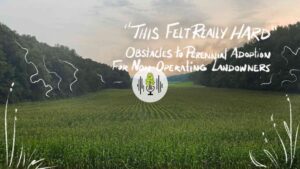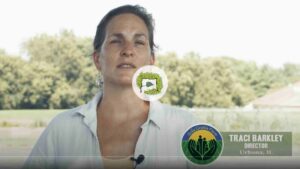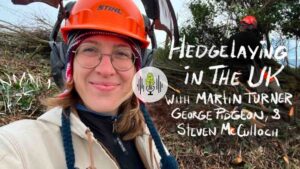“We Can’t Call Them Superfruit” – Barriers to Berry Markets with Bill Davison & PJ Connolly
We talk a lot about the farming side of agroforestry, and sometimes about the food side, but it’s just as important to talk about the financial side of agroforestry. In the latest episode of the Perennial AF podcast, Savanna Institute staff members Bill Davison and PJ Connolly explain how for some perennial berry crops, the primary barrier to scaling up production is not a lack of interest or a lack of knowledge, but a lack of market development.
Bill and PJ are focusing on four Midwest berry crops that have tremendous nutritional benefits, and they’re hoping to use the appeal and demand of two of them – elderberries and black currants – to raise the profile of some equally nutritious, but less-appreciated berries: aronia and honeyberry.
Transcript has been edited for brevity and clarity:
Bill Davison: A lot of things need to be done well to get a product to the point that a company will commit to it. And I think that’s what’s been missing from a lot of our work, is that type of expertise. We tend to focus on the farming side, the production side and getting the product. But now we’re going to have the berries. So it becomes a question of whether we can open up markets so the berries can move into those markets.
We have another project that’s around marketing, basically helping us to develop the language that we need to use around these berries. We learned that we cannot call them “superfruit”. The USDA made that clear. The FDA as well. They come after you if you say that. (Laughs.)
Jacob Grace: Not super duper fruit? (Laughs)
PJ Connolly: I’ll maybe just give a brief description of the various things that we’re working on with these four berry crops: black currants, elderberries, aronia, and honeyberries or haskap. We’ve thrown that last one in. We don’t work a lot with it right now, but we know that within the Midwest, there is a good number of people growing honeyberries.
So we’ve been doing work with these four different berries, trying to understand what the barriers are. And compared to nut crops, it seems like the primary obstacle to scaling up berry crops is markets and market development. Some of the berries, like Bill mentioned, have to be processed in order to actively tap into the markets. A lot of these markets that we need to tap into are going to deal with some level of value added processing. So in order to address that, what we’ve been working on is trying to get a bunch of stuff going in the arena of market development.
Bill Davison: I think with berries, it’s happening. Like, they are going to come to market at a larger scale. The bigger bottleneck or barrier just seems to be around agroforestry in general, and the way that farmers and the public view perennial plants. They don’t necessarily see them as crops, because our landscape is so dominated by annual crops. So there is really a psychological bottleneck. We need to help people see the potential in these crops, the resilience that they can bring. And the benefits, honestly, to the farmers that are operating within our current system. There would be tremendous benefits to widespread adoption of agroforestry.
Links
Black Currant: savannainstitute.org/blackcurrant
Elderberry: savannainstitute.org/elderberry
Aronia: savannainstitute.org/aronia
Honeyberry: savannainstitute.org/honeyberry
Grassland 2.0: grasslandag.org
Canopy: canopyfm.com
Listen to Recent Episodes

“This Felt Really Hard” – Obstacles to Perennial Adoption for Non-Operating Landowners
Host Jacob Grace talks with his friend Alex about her family’s experiences as non-operating landowners trying to establish perennial management on their historic Wisconsin farm, and the hurdles and roadblocks they have encountered along the way.

Agroforestry for Community Food Security
Sola Gratia in Urbana, Illinois grows food for a community where one in 10 people and one in eight kids don’t know where their next meal is coming from.

Hedgelaying in the UK with Martin Turner, George Pidgeon, and Steven McCulloch
This January, Savanna Institute staff member MJ Oviatt visited the UK to study hedgelaying with members of the Blackdown Hills Hedge Association. In this episode, we hear MJ’s recorded conversations with hedgelayers Martin Turner, George Pidgeon, and Steven McCulloch.

